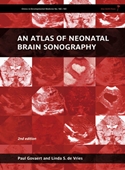This Atlas covers the entire spectrum of brain disease as studied with ultrasound, illustrated throughout with superb-
quality images. It is aimed at neonatologists and radiologists confronted with everyday clinical questions on the
neonatal ward. Most newborn brain disorders can be identified with ultrasound; this book will therefore be particularly
useful in settings with limited MRI facilities. Prenatal ultrasound specialists will also find it valuable as a
postnatal reference in their field of interest. Suggestions for differential diagnosis accompany all the sonographic
findings, guiding the clinician in proceeding from an abnormal image to a diagnosis. This second edition of the Atlas
has been brought up to date to include the many advances in technique and interpretation that have been made in the
past decade. The images have been replaced with new ones of higher quality, and all the line artwork has been
standardised and improved.
SECTION 1. NORMAL ANATOMY
1.1 Sulci and gyri; 1.2 Lateral ventricles; 1.3 Third ventricle; 1.4 Choroid plexus; 1.5 Lobar parenchyma; 1.6 Midline
structures; 1.7 Cisterns; 1.8 Basal ganglia and thalamus; 1.9 Brainstem; 1.10 Cerebellum; 1.11 General references on
normal anatomy.
SECTION 2. CONGENITAL ANOMALIES
2.1 Disorders of neurulation; 2.2 Cephalocele; 2.3 Hydrocephalus; 2.4 Intracranial fluid collections; 2.5 Unilateral
hydrocephalus; 2.6 External hydrocephalus; 2.7 Disorders of the corpus callosum; 2.8 Septal agenesis and malformation;
2.9 Hamartoma and accessory brain; 2.10 Cerebral hemiatrophy; 2.11 Microcephaly; 2.12 Schizencephaly; 2.13 Disorders of
neuroblast migration; 2.14 Median prosencephalic dysgenesis holoprosencephaly; 2.15 Posterior fossa anomalies; 2.16
Vascular anomalies.
SECTION 3. ANTENATAL BRAIN DAMAGE
3.1 Antenatal intracranial haemorrhage; 3.2 Global forebrain ischaemia before birth; 3.3 Germinolysis; 3.4
Hydranencephaly; 3.5 Porencephaly; 3.6 Multicystic encephalopathy; 3.7 Choroid plexus pseudocyst; 3.8 Moebius sequence;
3.9 Twin-associated antepartum brain damage; 3.10 Striatal vasculopathy; 3.11 Fetopath.;
SECTION 4. HAEMORRHAGE
4.1 GMH/IVH; 4.2 posthaemorrhagic ventricular dilatation; 4.3 Epidural haematoma; 4.4 Subdural haematoma; 4.5 Lobar
cerebral haemorrhage; 4.6 Cerebellar haemorrhage; 4.7 Bleeding into thalamus, basal ganglia and ventricle; 4.8 Term
IVH; 4.9 Subarachnoid haematoma and non-accidental injury.
SECTION 5. ASPHYXIA
5.1 Causes and clinical types of asphyxia; 5.2 Neuropathological paradigms; 5.3 Myelination; 5.4 Maturation of
sonographic changes; 5.5 Brain swelling; 5.6 Haemorrhage in areas of selective neuronal necrosis; 5.7 Parasagittal
cerebral injury; 5.8 Leukomalacia; 5.9 Selective neuronal necrosis to cortex, deep grey matter and hindbrain; 5.10
Primary cortical injury; 5.11 Focal infarction with asphyxia; 5.12 Cerebral blood flow velocity; 5.13 Combinations of
paradigms; 5.14 Scoring the gradation of injury.
SECTION 6. ISCHAEMIC STROKE
6.1 Arterial; 6.2 Venous sinus.
SECTION 7. PRETERM WHITE-MATTER INJURY
7.1 Pathogenesis; 7.2 Neuropathology; 7.3 Venous infarction; 7.4 Risk factors; 7.5 Timing; 7.6 Imaging aspects; 7.7 New
approach.
SECTION 8 MISCELLANEOUS
8.1 Kernicterus; 8.2 Hypoglycaemia; 8.3 Hyperglycaemia; 8.4 Inborn errors of metabolism; 8.5 Reversible encephalopathy;
8.6 Bacterial meningitis, ventriculitis; 8.7 Air embolism; 8.8 Craniocerebral erosion; 8.10 Brain perforation; 8.11
Neuroectodermal disorders; 8.12 Leukodystrophy; 8.13 Tumour.


